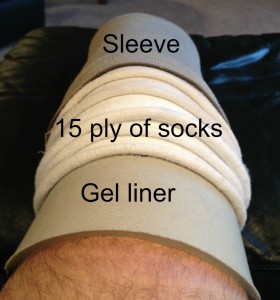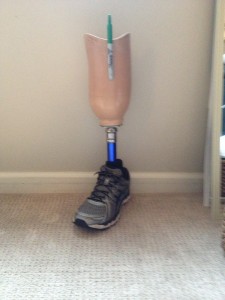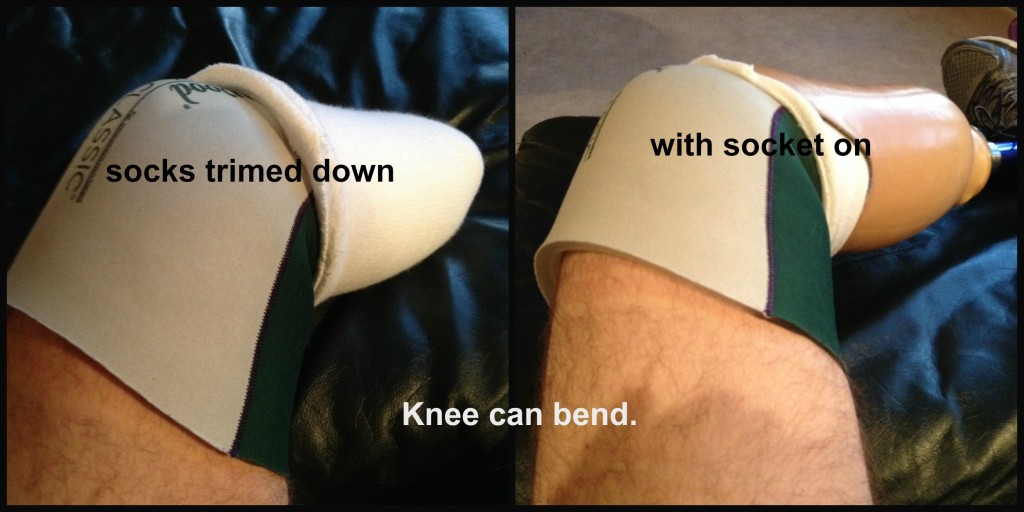 How many times have you heard or used the expression, “Just like riding a bike”? This expression refers to any skill that, once learned, you will never forget. While I have found this expression to be accurate, I have also learned that circumstances in life can make even riding a bike a skill to relearn. Who would have ever thought that figuring out how to keep your leg attached to your body would become a bicycling skill?
How many times have you heard or used the expression, “Just like riding a bike”? This expression refers to any skill that, once learned, you will never forget. While I have found this expression to be accurate, I have also learned that circumstances in life can make even riding a bike a skill to relearn. Who would have ever thought that figuring out how to keep your leg attached to your body would become a bicycling skill?
I knew that lower limb amputees ride bikes and I had no doubts that I would be riding eight to ten miles in no time. As with so many other things, as a new amputee I would need to relearn, do a little homework and make some adaptations.
At the end of March spring seemed to be stuck in a weather jam, delaying its arrival. So, in preparation for figuring out the bike riding with a prosthetic leg I joined a spinning class (indoor cycling) at the gym. My initial plan was to do the spinning class without the prosthetic leg. My prosthesis is considered a temporary leg, meaning one that is used to learn to walk with and get me by while the stump is taking shape. While my temporary leg is a very good one, I have not yet been comfortable using it for anything other than basic walking and doing household chores. I simply find that for my level of activity, I am more comfortable, agile and capable one legged.
On the day of the class I decided that there was no time like the present to give biking with the prosthesis a try, so I donned the leg and headed off to the gym for my spinning class. I confidently walked into the spin room and mounted a bike. Then. with the help of the instructor, who was my trainer Holly, I managed to get both my foot with blood pumping through it and the plastic-covered carbon fiber foot strapped into the pedals. Now settled on the bike I gave pedaling a try. Wearing a gel liner, layers of socks and the silicon suspension sleeve pretty much renders the rage of motion in my knee just barely enough to make a natural gait. So surprisingly, other than the pinching in the back of my knee with every turn of the pedal, pedaling really wasn’t that bad.
The class then began and I pedaled assiduously with no problems. Then the music picked up and Holly instructed us to increase the incline, come up off the saddle and pick up the pace. So I did just that; I went into standing position on the bike and gave it my all. My legs were pedaling rapidly, the end of what is left of my tibia felt as if it were boring a hole through my skin and with every pump of the pedal a vice was clamping down on the skin in the back of my knee, but I was keeping up with the best of them. Suddenly I hear a crashing noise beneath me. I quickly look down and realize that I have pedaled right out of my leg. Still attached to the pedal by the foot, the prosthesis was off Stumpy and had toppled over on the floor. I quickly reached down, pulled it off the pedal and completed the spin class pedaling with my one leg.
Holly can now warn her spinning classes “Watch out, I had a guy spin his leg off!”
Where did things go wrong? There were a few issues with biking with the prosthetic leg.
The first being all the layers that are required to make the prosthesis comfortable and keep it on. A gel liner about an eighth of an inch thick is placed over Stumpy and comes up over the knee. At that point my friend had shrunk considerable since the leg was made. To account for the change in Stumpy’s size socks are added to take up the space. At the time of the spinning class I was wearing 10 ply thickness socks over the liner, which is the equivalent to wearing ten layers of basic cotton socks. The layers were topped off with the suspension sleeve, which is another eighth of an inch thick. In total I probably had at  least three quarters of inch of layers around my knee. Trying to pedal a bike with all those layers tightly fitted around your knee is like riding a bike wearing a knee immobilizer. It is very difficult and painful to maintain the range of motion necessary to pedal a bike. The second issue that came into play was that the pedaling of a bike causes Stumpy to lose volume. Fluids get trapped in the tissues, causing swelling. Indeed, exercise aids in releasing the trapped fluid out of the tissues, and it also increases blood circulation that helps to flush out the excess fluids. So, the pedaling was pumping the fluids out of Stumpy, causing it to rapidly decrease in size and making the socket loose. The final problem was that the suspension sleeve is designed to stick to the top of the socket and the skin on the thigh helping to hold the prosthesis on. The suspension sleeve is made of silicone and is pulled up over the socket and thigh to create an airtight seal between the thigh skin and the top of the prosthesis. The more skin-to-sleeve contact, the stronger the hold. With all the layers underneath, only about two inches of the suspension sleeve made contact with the skin. Add in the moisture from the sweat and the suspension sleeve slipped right off.
least three quarters of inch of layers around my knee. Trying to pedal a bike with all those layers tightly fitted around your knee is like riding a bike wearing a knee immobilizer. It is very difficult and painful to maintain the range of motion necessary to pedal a bike. The second issue that came into play was that the pedaling of a bike causes Stumpy to lose volume. Fluids get trapped in the tissues, causing swelling. Indeed, exercise aids in releasing the trapped fluid out of the tissues, and it also increases blood circulation that helps to flush out the excess fluids. So, the pedaling was pumping the fluids out of Stumpy, causing it to rapidly decrease in size and making the socket loose. The final problem was that the suspension sleeve is designed to stick to the top of the socket and the skin on the thigh helping to hold the prosthesis on. The suspension sleeve is made of silicone and is pulled up over the socket and thigh to create an airtight seal between the thigh skin and the top of the prosthesis. The more skin-to-sleeve contact, the stronger the hold. With all the layers underneath, only about two inches of the suspension sleeve made contact with the skin. Add in the moisture from the sweat and the suspension sleeve slipped right off.
While I managed to successfully complete the remaining three quarters of the hour class pedaling with one leg, I really wanted to bike using the prosthetic. Having two legs makes the ride more pleasant. Also, for the spinning class without the leg, I am not able to come up off the saddle. The most important thing is that being able to bike with the prosthetic on will give a great deal of benefit in building strength in my severely weakened thigh of the stump leg. So, I went to work solving the problems and enable myself to successful bike without pain or my leg falling off. (Now that’s a statement you don’t hear often.)
While I seriously considered duct-taping the prosthesis on, I felt it not a wise idea. It would hurt like hell pulling duct tape of my hairy Sasquatch leg. I needed to reduce some of the layers around the knee and find a way to hold the prosthesis on more securely.
I wanted to take a gel liner and trim it down to about an inch above the socket. This would greatly reduce the thickness around the knee and make a huge difference in range of motion. It would also give considerably more skin-to-sleeve contact, helping to hold the leg on. A gel liner cost $250+, so after much searching online I found a gel sock. While my prosthetist would have a heart attack, I ordered it despite the warning that it should not be used as a liner. When it came I tried it on. It was not as thick as the gel liner but not as stiff either. With the gel sock and all 15 ply of socks I could bend my knee with much more ease. However, the problem was that I couldn’t bear weight and I still had space in the socket that needed to be filled. The sock was packaged with a 1-inch piece of foam rubber stuffed in it. I took the foam rubber and folded it over the end of Stumpy and then held it in place with the socks. While it was painful to take more than a few steps, I hoped it would work adequately for pedaling my bike.
I grabbed my crutches to help with the weight bearing to get to my bike. Climbing on the bike and strapping the prosthetic foot onto the pedal was no easy feat, but I accomplished it and was off. I had ordered new bike pedals over the winter that had straps, which I had installed earlier that day. I had thought I would not be able to keep my foot on the pedal without strapping it
I felt awkward and wobbly but made it to the end of my street with no incidents. The gel sock with foam rubber topped off with 15 ply of sock was as comfortable as it could get for pedaling the bike. (After all, the prosthesis is a wonderful tool and has made my life easier in many ways, but I have yet to say it is comfortable to wear.)
My troubles happened when I stopped for traffic at the end of my street. I put my real foot down on the pavement while I waited for the traffic so I could cross the road. When I got a break in traffic, I quickly brought my blood-flowing foot back up on the pedal. In doing this I lost balance and toppled over on the prosthetic leg side. I was sprawled out in the center of the road at the intersection of the main road and my street, my fake foot strapped in the pedal and the bike on top of me. Luckily the prosthetic leg took the brunt of the fall and I was not hurt. Although stunned for a few seconds, I released the foot from the strap and staggered back up on my feet as quickly as possible. Feeling discouraged, I got back on the bike without strapping the foot on the pedal and headed back to my house. By the time I got back to my driveway I realized that I could pedal better without having the foot strapped in. I turned around and went back to the end of the street and crossed the main road to the bike path. I successfully biked approximately a mile.
After I returned home and began to walk back into the house to switch back into my proper liner I realized my foot was rotated inward. The fall had put enough force on the foot that it rotated it. On the positive side the next morning I corrected the foot aliment with an Allen wrench as per instructions from my prosthetist over the phone. If it had been a real leg I would most likely have been in the hospital having surgery to repair a broken bone.
Over the next week I had an epiphany. It would be smarter and much cheaper to shorten the socks vs the gel liner. I quickly went online and ordered the equivalent to 15 ply of extra socks. When they came I trimmed them all down to the top of the socket of the prosthetic leg. This way I had the layers to fill up the space where I needed them, but I was not straddled with all the extra bulk around the knee. Not only did this solve the biking issue, but it also took considerable pressure off my knee for walking.
In the next few weeks I built up the tolerance of pedaling with the prosthesis and distance with each ride. I am now riding ten plus miles, keeping my leg attached and loving it. Once again my determination kicked in and I didn’t allow myself to give up despite the discomfort and early biking incidents. Soon I might even go back to saying “Just like riding a bike.”
I will be participating in the Tour-de-Cure fundraising cycling event to benefit the American Diabetes Association on June 7th. I will be biking 25 miles.
I would be honored if you would consider helping me reach my goal in supporting the American Diabetes Association by checking out my personal Tour-de-Cure page and making a donation.
Thank you for reading! Please subscribe to never miss a post or come back in two weeks for my next post, I will discuss the “One limb for life” rule.
Also follow my story on Facebook.





